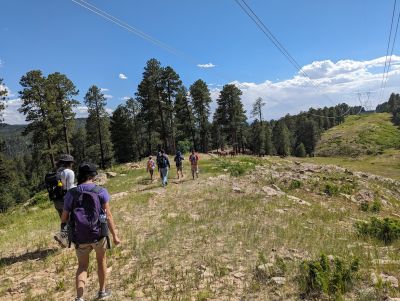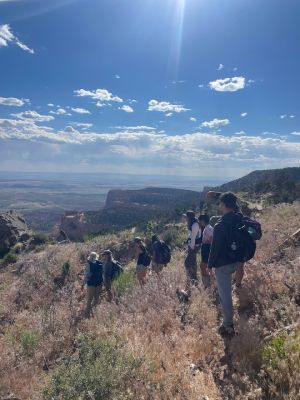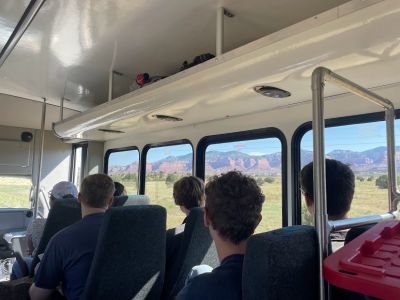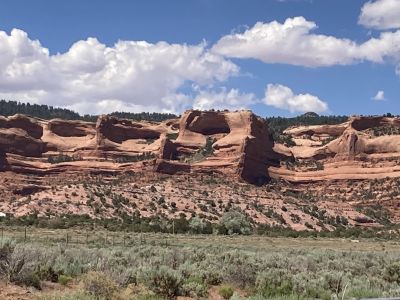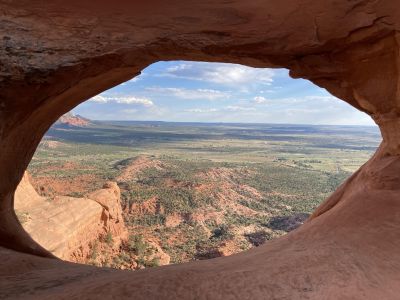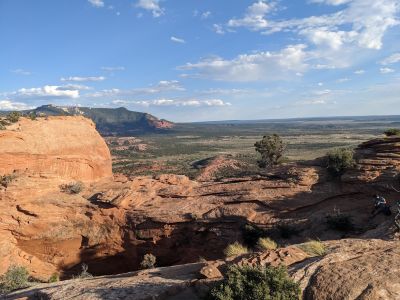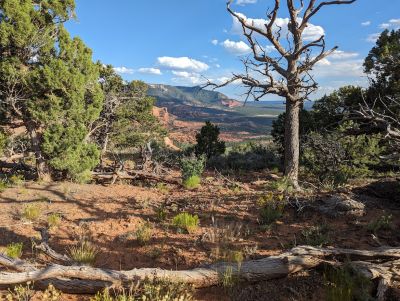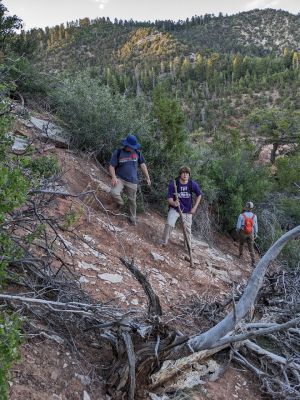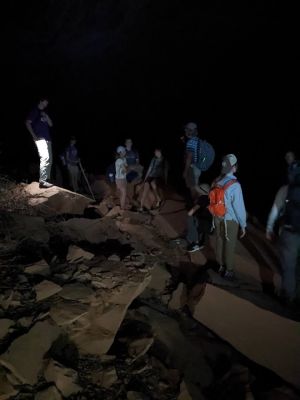Lukas Bontrager-Waite shares his insights after a challenging experience in the Chuska Mountains:
There is a question that has especially been on my mind since this SST began: “what are we bound by?” Generally, my answer has always been the same: time. In our culture and society in Goshen, Indiana, I would maintain that this is true. We have deadlines, age milestones (18 to vote, 21 to drink alcohol, 55 to get senior discounts at most restaurants), and only so many hours in any given day to work, spend time with family or friends, do chores, exercise, etc. We are limited by time. We are also rarely limited by space, except on very special occasions.
Monday, July 3 was one of those very special occasions. Thirteen students and their fearless leader, Jerrell, set out in the afternoon for a hike in the Chuska Mountains, starting just shy of Buffalo Pass. The distance, terrain, and difficulty were unknown to most everyone except for our guide, Bryan Roessel. Bryan is also the son of the president of Diné College, where we had been staying for a week.
We followed Bryan’s truck along a winding highway and dirt roads up to the forested mountain range in the Goshen College minibus, a clumsy vehicle that is surprisingly more capable off-road than one would expect. We eventually stopped next to buzzing, high-voltage power lines and got off the bus, stocked up on sandwiches, chips, and gatorade, and began our hike.
The first stretch was fairly easy. We followed a grassy road west along the power lines, surrounded by bugs, lizards, cows, and cow pies. After about half an hour we all stopped when the trail became incredibly steep and were greeted with one of the best views of the trip — a landscape that stretched out for miles, filled with trees, buttes, and hazy mountains in the distance. At this point, I got confused and asked Jerrell where our destination was — the view seemed pretty good already. He pointed at a section of the mesa Bryan had indicated that was about two miles away and hundreds of feet downward through cliffs and uncleared pines, and I got a little unsure of what we had gotten ourselves into.
The next stretch was fairly not easy. Bryan led us down the sandy slopes through rock scrambles, patches of cacti, and dead tree branches that were particularly adept at scratching human skin. For the less outdoorsy of the bunch it got harder and harder to keep up. We ended up fracturing into a few different groups at this point, and it didn’t help that the trail we were following was an old sheep trail rather than a hiking trail. At a certain point it became a matter of following footprints.
Eventually, after stopping to consolidate the group and then subsequently breaking apart the group several times, we finally reached what Jerrell had pointed to earlier: the site known as Hole in the Rock. We ate dinner next to another beautiful view and the titular hole in the rock, a 10 foot wide opening in the cliff.
After about an hour of eating, hydrating, and photo taking, we set off for the minibus. The sun was close to setting, so this time around we took a different route to reach a lower section of the main road rather than climb up the steep mountain the way we came to reach the bus. It was supposed to be shorter, and while it was shorter, it was also harder. Much harder.
After about 10 minutes of what I would call easy hiking, we all stopped and Bryan had to scout out the way ahead. He had a general sense of which direction he was supposed to go, but there was no trail and he had not gone this way for a long time. We began a rock scramble that was steeper and longer than anything we had done before. Many of us acquired walking sticks to use for balance during the series of controlled slides down the mountain, but these did not prevent sand and small pebbles from making new homes in our hiking boots.
The hike developed a pattern of these long scrambles and brief stretches of walk-able terrain, before we passed through a dried up creek and approached a small cliff. Bryan pulled out a length of rope and guided us carefully down the 15 foot drop, with maybe a few inches across for every foot downward. This split us into two groups: the group in the back (the one I was in) had those not prepared for this kind of trek and some who were helping them along the way and the group in the front had the plucky, bright-eyed adventurers more than happy to face the wilderness.
It was also here that the sun set and we realized that this day hike was turning into a night hike. We now had to go in the dark, and this made me first question: are we going to get out of here? Not if we would be out before dark or if we would be back in time to make it to the 4th of July rodeo the next day — no, I wondered if we would be able to get out and escape the wilderness without cell service or other luxuries we are used to.
Surrounded on all sides by high stone walls, pine trees, and dense bushes, we pulled out our flashlights and went on our way. We cut through the thick brambles to catch up with the rest of the group, who had been waiting in a large cavern with sheep bones inside of it. We got our bearings, and Bryan went in front to lead us in the dark through another section without a trail.
After more tedious bramble clearing, we naturally split up again into similar groups, this time with Jerrell in the back and Bryan in the front. Shortly after splitting up, those of us in the back heard a loud crack up ahead. There were some shouts and cries, then the echoing sound of dozens of rocks crashing and crumbling against each other, and then silence.
To me, it sounded like someone had fallen in a landslide. Seth and Jerrell immediately rushed ahead to see what had happened. The rest of us caught up shortly after to find Jonathan at the bottom of a long rock scramble, bleeding from his head. Alex had taken off his shirt and Julia was using it to put pressure on the wound, as he helped treat it with his first aid kit. The rest of us stood around in horror wondering if Jonathan would be alright.
As I have been informed, a couple minutes prior to this scene, the group in front had reached the scramble and had started going down. Bryan and Craig led the way, and Jonathan and Alex followed behind them. After Jonathan had made his first few steps downward, Alex touched a large rock for support. The moment he did, it shifted out of place and slowly began sliding down. Bryan jumped out of the way of it immediately, but the suit-case sized boulder bruised Craig’s leg and glanced the side of Jonathan’s head, leaving an inch-and-a-half long cut.
Craig hardly felt it, and Jonathan was alright after getting his wound wrapped in gauze. He ended up receiving 10 stitches at Chinle Hospital later that night. However, as he was getting patched up and we waited to see what would come of his injury, I wondered again if we would get out. We were under an incredible amount of stress, especially since the way ahead was equally unclear. Bryan and Craig had to run ahead to see if they could find a way to the main road from there. Bryan had said somebody would be waiting for us when we reached it.
Thankfully, after a few nervous conversations and tense pauses, they returned to tell us they had figured out how to get to the road. We crossed a creek and managed to make our way up one final rock scramble, before following one of the clearest paths of the hike.
We took this path all the way to the road, where we were greeted by a couple of pick up trucks and Bryan’s dad, Dr. Charles M. Roessel, the president of Diné College. Bryan told us all to “grab a cold ____ water” and either find a seat or hop in the back. I took my spot in the back, and watched our surroundings blur in the darkness as we took off for the minibus. Some of us let out loud screams, some of us recounted moments of the hike, and some of us stayed silent, all of us occasionally lit by the glowing red brake lights of the truck.
Eventually, we heard the familiar sound of power lines buzzing, and we pulled up next to the bus. We got off and Bryan had us gather around and told us that the mountains knew us now. They had challenged us and we completed their challenge. He told us to let out a mighty yell (mine sounded more like a shriek) and invited us to say a prayer to one of the nearby trees. He gave us corn pollen and told us to touch it to our lips, then our head, and then release it. I took mine to a stout tree lacking nettles, and before I could say a prayer it poked me in the eye with one of its branches. I said my prayer to it none the less, thanking the tree and the mountain for letting us get out relatively unharmed. I turned away and looked up at the almost full moon and stars surrounding it. After a brief stretch of silence, we said our goodbyes, filed onto the bus, and headed back to Diné College.
I cannot stress enough the determination of Bryan, Jerrell, and the rest of the students. Not even Bryan knew the difficulty of the second half of the hike. They all really could have panicked and lost control of the situation, especially after a boulder struck the side of Jonathan’s head, but they didn’t.
In that sense, as I reflect on it, the first half of the hike really wasn’t all that important to the experience, or at least it had much less of an impact. The views were beautiful, but going through the wilderness in the dark without a trail is what I will actually remember. It made me feel completely trapped: the land was in control of me.
This again brings up the question: “what are we bound by?” More and more with technology we are connected with people and places across vast distances around the world, and if we want to go anywhere we can buy a plane ticket. I guess in that sense money serves as a proxy for limiting space. Throughout the summer, we have heard of the space vs. time divide between many Indigenous cultures and Western culture, and on that Monday, I felt like I was truly limited by space — the land — for the first time in my life.
When I think back to that night when Bryan had us say a prayer to a tree, I think about the land, developing a relationship with it, and how a space-oriented culture thinks about it. It is meant to challenge you, and those challenges build up your relationship. It’s no wonder that as a society who is rarely challenged by the land we feel so disconnected from it. On that hike, as the sand, rocks, and sharp plants challenged me, I felt like a visitor — a guest in a very inhospitable home. And as Bryan pointed out, once we were done, we made an impression. We didn’t conquer it or domesticate it — we had simply managed to travel through it, and in subsequent weeks when I returned to the area surrounding Buffalo Pass, I wondered: do these trees recognize me?

